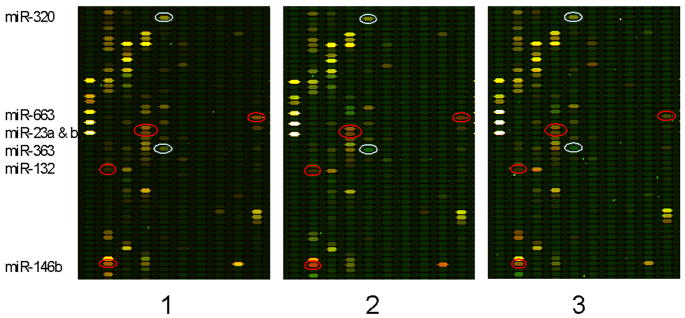To assess the feasibility and relevance of using lymphoblastoid cell lines to study the role of noncoding RNAs in the etiology of autism, researchers at Children’s Mercy Hospitals and Clinics used LC Sciences’ microRNA microarray service to evaluate global expression profile of 470 mature human microRNAs from six subjects with autism compared with six matched controls. Differential expression (either higher or lower) for 9 of the 470 microRNAs was observed in our autism samples compared with controls. Potential target genes for these microRNAs were identified using computer tools, which included several autism susceptibility genes. Our preliminary results indicate microRNAs should be considered and evaluated in the etiology of autism. In addition, analysis of this class of noncoding RNAs in lymphoblastoid cells has the potential to reveal at least a subset of brain-related microRNAs implicated in autism. Subsequently, this model system should allow for detection of complex subtle changes in susceptibility genes/pathways contributing to autism.
Cy3/Cy5 ratio image of microRNA microarray expression.
Representative microRNAs differentially expressed in 3 autism compared with 3 control females are marked with color code (red: up regulation and green: down regulation). Tissue source: lymphoblastoid cell lines. Pair sets: #1 = 6 yr old autism/6 yr old control; #2 = 11 yr old autism/12 yr old control; and #3 = 13 yr old autism/13 yr old control.
Related Service
miRNA Microarray Service – LC Sciences provides a microRNA (miRNA) expression profiling service using microarrays based on our in-house developed µParaflo® technology platform. We have standard arrays for all mature miRNAs of all species available in the latest version of the miRBase database (Release 21, July 2014). Our service is comprehensive and includes sample labeling, array hybridization, image data processing and in-depth data analysis. Two-three weeks after receiving your total RNA samples, we’ll send you both the raw and fully analyzed data. [Learn more…]
Reference
Theodoro M, Talebizedah Z. (2008) Feasibility and Relevance of Examining Lymphoblastoid Cell Lines to Study Role of microRNAs in Autism. Autism Research 1(4), 240-50. [article]

